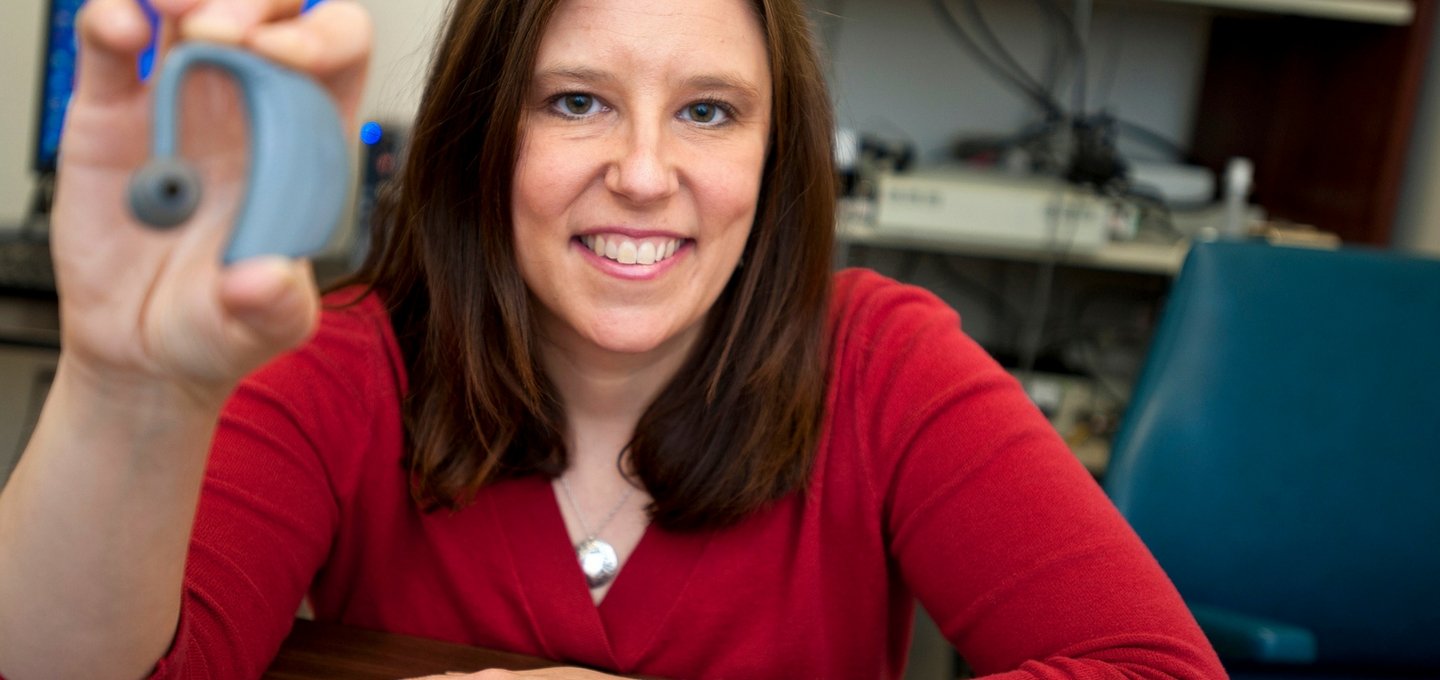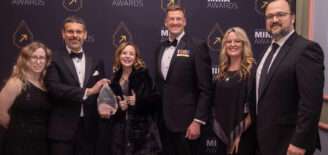SpeechVive helps people with Parkinson’s regain their voice and reconnect
When funding for a university incubator fell through, Steve Mogensen had the opportunity to license one of the many technologies coming out of Purdue’s vast research and development network. Twenty years of experience in the medical devices industry helped Steve narrow down the options, but it was an impromptu trip to Florida at the invitation of Dr. Jessica Huber that changed Steve’s life.
Huber, a Ph.D. in speech science, was researching whether or not people with Parkinson’s disease still respond to the Lombard reflex: the involuntary tendency of speakers to increase their vocal effort when speaking amidst noise. During the trip, Steve experienced the heartbreaking challenges people face with Parkinson’s, as well as the passion Dr. Huber has for helping them. His decision was made.
The pair founded a company together called SpeechVive that would go on to change the lives of people with Parkinson’s disease as well as the lives of the people who love and care for them.
The company’s primary product is a non-invasive, over-the-ear device that looks a lot like a hearing aid, but it’s a lot more than that. With SpeechVive, the device detects the patient’s speech and delivers a sound stimulus into the ear, which triggers the Lombard reflex and causes the patient to speak louder and more clearly.
“My motivation in moving the technology behind SpeechVive forward is making life better for people with Parkinson’s disease,” Dr. Huber said.“Being able to communicate is critical to connecting with family and friends. So many people with Parkinson’s disease withdraw from their relationships because they are frustrated with the difficulty communicating. I really want to make a difference in these patients’ lives.”
Ninety percent of people who use SpeechVive get a significant benefit — 75 percent get the benefit immediately and another 15 percent need a few weeks of using the device before getting the full effect. There is also a free SpeechVive app for iOS that uses standard earbuds to test for the Lombard response. The app allows people to see if SpeechVive will work for them before they buy it, and the company also has a “no questions asked” 60-day money back guarantee.
When people think of Parkinson’s, they think about the tremors, but one of the most common symptoms of Parkinson’s is a loss of communication (89 percent) due to the patient’s inability to regulate their speech. To their friends and family they seem to be mumbling, or speaking too softly. As a result, people with Parkinson’s get interrupted and talked over, and this often leads to isolation and depression. SpeechVive, as the company moniker states, gives people with Parkinson’s their voice back by “Reviving Speech, Improving Lives.”
“Most of the time it’s the spouse or a family member who calls us and says, ‘I can’t even tell you what an impact this has made in our lives,’” Steve said.“Sometimes people who haven’t had a conversation in years start talking again and calling their grandkids and engaging in life again. There can be a lot of dark days at a startup, but when you hear from someone and they tell you what a difference you’ve made, that will charge the batteries for a while.”
SpeechVive developed the device during clinical trials with a large group — 80 patients and their caregivers — which resulted in a product that avoids the issues so often associated with other medical devices. There are no batteries to replace, for example, because the device has a rechargeable lithium ion battery. It comes with its own charging station with an easy access lid, and the device sits in its cradle connection rather than needing a USB connection because people with Parkinson’s often have trouble with manual dexterity tasks like that. SpeechVive partnered with Cellaflora software developers in West Lafayette, Ind. and Engineered Medical Systems contract manufacturing in Indianapolis to bring the device to market, making it 100 percent designed and built in Indiana.
SpeechVive is the only device of its kind that has multi-site, peer reviewed, published clinical trials, which is one of the reasons it’s done so well on word-of-mouth sales and marketing alone, especially in 35 of the nation’s Veterans Affairs medical centers. The other reason is because of the company’s intuitive software and unparalleled clinician support.
The device is calibrated to a wearer’s individual speech profile by a trained speech pathologist as part of a routine speech therapy visit. SpeechVive provides peer-to-peer clinical support for speech-language pathologists to address any issues that may arise. “It’s our policy to stop and drop everything and get on the phone to help clinicians or patients when they call,” Steve said. SpeechVive also received an SBIR Phase II grant from the National Institutes of Health to develop a telemedicine platform that allows the device to be programmed over the Internet. The telehealth platform is currently being tested in multiple sites from small private practices to large movement disorders clinics including Wake Forrest and Northwestern.
Funded by the Indiana Seed Fund II, the Elevate Purdue Foundry Fund and private investors, SpeechVive is a small startup with only three full-time employees, but a new hire, a vice president of sales, will start in June and lead the company’s first dedicated sales effort. Steve explained that the next six to nine months will be critical as the company executes well on its sales and marketing strategy, but that he expects SpeechVive to be hiring more sales and marketing, clinician support, customer support and operations staff into 2019 and 2020.





